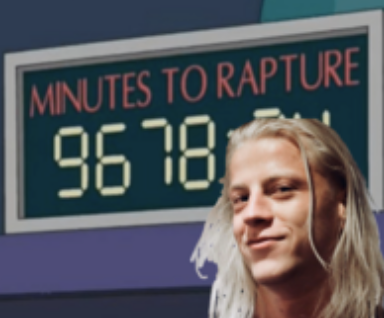
Fear is a scientifically well-understood emotion that evolved to allow organisms to swiftly mobilize resources in times of need. Indeed, it is well-documented that organisms universally respond with fight, flight or freeze behavior when faced with actual or potentially dangerous situations. What is much less well understood is how fear becomes the engine in pleasurable activities—what could be termed “recreational fear.” Fear-seeking activities range from mildly scary children’s activities, such as playfully being chased by a parent or caregiver, to full-blown horror media, such as horror films and haunted attractions. Such media entertainment is both culturally pervasive and exceedingly popular. Recreational fear, in other words, is a widespread phenomenon that requires empirical investigation in its developmental, psychological, social, cultural and biological dimensions. ‘When Fear is Fun’ is a one-day international and interdisciplinary workshop that will bring together media scholars, philosophers, communication scientists, psychologists and cognitive scientists for the first systematic exploration of the interactions between these spheres of research.
The conference will be held online via zoom on August 26, 2021.
Marc Malmdorf Andersen
Mihaela Taranu
Mathias Clasen
See the Registration below
| Time | Presentation | Speaker |
|---|---|---|
| 09:00-09:10 | Welcome | Recreational Fear Lab |
| 09:10-09:50 | The New Science of Recreational Fear | Mathias Clasen & Marc M. Andersen |
| 09:50-10:40 | Learning from fear – What self and other experienced threat learning can teach us about the lure of horror | Andreas Olsson |
| 10:40-11:30 | Horror Film and Affect: The Experiential Dynamics of Cinematic Fear | Xavier Aldana Reyes |
| 11:30-12:15 | The Good, the Bad and the Ugly of Horror | Mark Miller |
| 12:15-12:45 | LUNCH | |
| 12:45-13.35 | Infants, Toddlers and Recreational Fear: A Study of Recreational Fear in Danish Nurseries and Kindergartens | Lauritz Holm Petersen & Emilie Schjoldager |
| 13:35-14:25 | Horror Films for Children; or, reimagining the horrific child through children's cinema | Catherine Lester |
| 14:25-15.15 | Affording Insights into Fear: Using Highly Interactive Media to Study Fear Processes | Teresa Lynch |
| 15:15-16:00 | Panel Discussion | All speakers |
| 16:00 | Goodbye |
Andreas Olsson is professor of psychology at the Department of Clinical Neuroscience at Karolinska Institutet, KI, heading the Emotion Lab. Before joining KI, Andreas completed his Ph.D. in psychology at New York University and post-doctoral studies at Columbia University. His research aims at better understanding the neural and behavioral mechanisms of threat and safety learning, and decision-making, in social situations.
Dr Xavier Aldana Reyes is Reader/Associate Professor in English Literature and Film at Manchester Metropolitan University and a founding member of the Manchester Centre for Gothic Studies. His books include Gothic Cinema (2020), Horror Film and Affect (2016) and Body Gothic (2014)
Mark Miller is a philosopher of cognition. His research explores what recent advances in neuroscience can tell us about happiness and well-being, and what it means to live well in our increasingly technologically-mediated world. He is an assistant professor at Hokkaido University’s Center for Human Nature, Artificial Intelligence and Neuroscience.
Dr Catherine Lester is Lecturer in Film and Television at the University of Birmingham. Her monograph Horror Films for Children: Fear and Pleasure in American Cinema will be published in Autumn 2021. She has also published chapters in the collections Global TV Horror (eds. Abbott and Jowett, 2021) and Discussing Disney (ed. Davis, 2019), and is currently editing a volume on the 1978 animated film Watership Down for Bloomsbury’s Key Animated Films/Filmmakers series.


Lauritz Petersen is an MA student at the Department of the Study of Religion, Aarhus University and a research intern at Recreational Fear Lab, with specific interest in modern ‘end of the world’ beliefs from a biocultural and cognitive perspective.
Emilie Schjoldager is an MA student at the Department of Psychology, Aarhus University and a research intern at Recreational Fear Lab, with particular interest in dark sides of human nature, such as why we sometimes commit evil acts and why we enjoy watching these in scary entertainment.
Teresa Lynch (Ph.D., Indiana University) is a communication scientist with expertise in the processes and effects of fear with specific interest in fear experienced in video game contexts. Teresa is Assistant Professor in the School of Communication at The Ohio State University and director of Chronos Laboratory
Marc Malmdorf Andersen is assistant professor at the Interacting Minds Centre, Aarhus University. His research focuses on the relationship between play, enjoyment and learning, using experimental approaches and cognitive frameworks, and his research has been published in journals such as Psychological Science, Phenomenology and the Cognitive Sciences and Poetics, and his new book Play comes out in 2021.
Mathias Clasen is associate professor of literature and media in the English Department at Aarhus University and director of the Recreational Fear Lab. His research focuses on the psychology and history of scary entertainment across media. He is the author of Why Horror Seduces (OUP, 2017) and the forthcoming A Very Nervous Person’s Guide to Horror Movies (OUP, 2021).
Recreational fear finds a prominent expression in present-day entertainment media, such as horror movies and scary video games, but the phenomenon exists in a range of domains and has deep historical roots in narrative traditions such as folktales, cautionary tales, and religious narratives. This talk gives a brief historical survey of recreational fear with a focus on scary media in Western entertainment culture. From folktales featuring uncanny monsters to terrifying survival-horror video games, popular culture brims with frightening imaginative products. Such products provide rich fodder not just for nightmares and enjoyable leisure activities, but for data analysis in the emerging interdisciplinary domain of recreational fear research, which involves both humanistic and social science disciplines such as psychology.
Across species, individuals regularly submit themselves to threatening situations. For example, a prey might approach a predator motivated by the search for food or to learn about the danger and potential strategies for future escape. Yet, animals can avoid such costly self-experienced trial-and-error learning through observing others’ responses to danger, motivating an interest in observing others under threat. Here, I will discuss research on humans and rodents using behavioral and brain imaging techniques examining social learning of threat, and its transfer to decision-making. Our results show that both self and other experienced learning draw on partially overlapping (domain general) learning mechanisms, involving, for example, the amygdala and periaqueductal gray. During social learning, these domain general mechanisms dynamically interact with social cognition determining the learning outcome. The study of social threat learning is fundamental to understanding how and why adaptive, as well as non-adaptive, emotional information spreads between individuals. It might also provide insights into why individuals across the animal kingdom are attracted to situations posing a potential threat to either themselves or others.
This talk contextualises my research into the affective nature of horror cinema, from my interest in the connections between the bodies of characters and those of viewers, particularly representations of graphic violence, to the use of cinema’s unique audio-visual characteristics (sound, images, editing) to generate fictional approximations of perceptual threat. I seek both to summarise my conclusions in Horror Film and Affect, a book in which I separated what I see as horror cinema’s three affective dimensions or levels (the representational, the emotional and the somatic), and to extend my original discussion by encompassing new exciting research into cognate media (like video-games) that can help us continue to experientially concretise the manifold expressions of cinematic fear and their intended effects.
Starting from the predictive processing framework, I will explore a few of the many reasons that an agent built to minimize uncertainty might be attracted to horrifying and highly uncertain materials (e.g. books, movies, games, etc.). The answer turns out to be complex - with some forms of attraction leading to significant benefits for predictive agents like us, while others are less adaptive and even potentially dangerous. Casting a light on the computational mechanisms underlying our experience of, and attraction to, horror can help tease apart these varying modes of attraction, and so help us better understand the value and dangers of horror.
Every day, Danish infants and toddlers are exposed to scary activities, and these are often deliber-ately initiated and facilitated by their caretakers. In fact, many nursery and kindergarten teachers report that they believe that scaring children is central to their jobs; according to them, fear-induc-ing activities are fun, formative, and a necessary part of a child’s psychological development.
In this talk, we’ll present findings from a series of expert interviews with child-care workers from Danish nurseries and kindergartens. Our study indicates that fear-related activities are surprisingly frequent in these institutions. Furthermore, our study suggests that scary activities are a tacitly ac-cepted part of Danish child-care tradition and that teachers expertly and with great sensitivity carry out these activities while constantly monitoring children’s response to fear-inducing stimuli and thereby making sure that they have a good experience. Finally, our results reveal that Danish nursery and kindergarten teachers believe scary activities help children explore their own emotional range while developing their curiosity towards what is scary as well as bewitching.
Children and horror are often thought to be an incompatible meeting of audience and genre, beset by concerns that children will be corrupted or harmed through exposure to horror media. Nowhere is this tension more clear than in horror films for adults, where child characters are presented as either helpless victims in need of protection or monstrous villains to be tamed or destroyed by adult protagonists in order to preserve the adult-child social hierarchy. However, horror for children is a unique category of contemporary Hollywood cinema in which children are addressed as an audience with specific needs, fears and desires, and where child characters simultaneously occupy the categories of protagonist, victim and monstrous ‘other’. Children’s horror films thus allow for an alternative reading strategy that interprets horrific child characters as offering child spectators a range of affective possibilities, including subversive identification, carnivalesque pleasure and recreational fear. Horrific children, in their defiance of adult authority and traditional conceptions of ‘child-friendly’ behaviour, mirror the child audience for whom the act of viewing horror is itself transgressive and subject to adult worry and restriction. By considering the fears and pleasures made available by the horrific child in films such as Gremlins (1984), this paper asks: what happens to the horror genre, and the horrific children it represents, when children are the target audience?
Entertainment media (e.g., film, novels) can evoke intense emotions in audience members. Video games present a compelling context in which to study emotion, given their high degree of interactivity relative to other media. When it comes to fear, for example, players are not indirect witnesses to mediated horror as they would be when watching a film. Rather, in video games, the player participates in the mediated horror’s unfolding. The richly interactive contexts of video games present opportunities for the player to respond to mediated threats, which presents opportunities for researchers to understand the over time nature of fear more fully. This talk will discuss the results of empirical social scientific research related to fear and argue that video games provide an excellent context in which to advance knowledge on fear.
Deadline registration: 25th of August, 2021, 17.00pm CET.
The workshop will be hosted on Zoom. Login details will be sent on the 25th of August to all those registered.